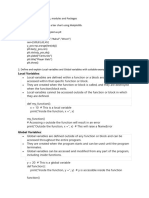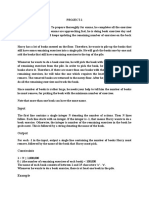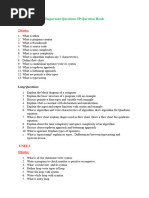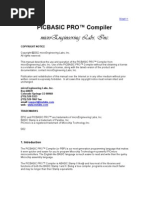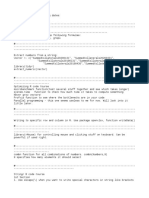Expanded List of Additional Built-In Functions
Uploaded by
Bandari GaneshExpanded List of Additional Built-In Functions
Uploaded by
Bandari GaneshHere’s an expanded list of additional built-in functions, methods, and useful operations available in
Python.
Additional Built-in Functions:
1. Advanced Iterators and Generators:
iter() : Returns an iterator object.
next() : Retrieves the next item from an iterator.
2. Functional Programming Tools:
lambda : Creates an anonymous function (inline function).
reduce() : Reduces an iterable to a single value by applying a function (available
in functools module).
functools.partial() : Allows partial function application, creating a new function with some
arguments pre-filled.
3. Advanced Type Conversion:
ord() : Converts a character to its ASCII/unicode value.
chr() : Converts an ASCII/unicode value to its character equivalent.
ascii() : Returns a string with a printable representation of an object.
repr() : Returns a string representation of an object (used for debugging).
frozenset() : Converts a collection to an immutable set.
4. Modules and Attributes:
__import__() : Imports a module programmatically, similar to the import statement.
globals() : Returns a dictionary representing the current global symbol table.
locals() : Returns a dictionary representing the current local symbol table.
vars() : Returns __dict__ attribute for a module, class, instance, or any other object with
attributes.
5. Memory-related Functions:
memoryview() : Creates a view object that exposes a buffer's data.
bytearray() : Returns an array of bytes.
bytes() : Converts an object to an immutable bytes object.
6. Specialized Mathematical Functions:
hex() : Converts an integer to hexadecimal.
bin() : Converts an integer to binary.
oct() : Converts an integer to octal.
complex() : Creates a complex number.
round() : Rounds a number to a specified number of decimal places.
divmod() : Returns the quotient and remainder as a tuple.
7. Sorting and Reordering:
all() : Returns True if all items in an iterable are true.
any() : Returns True if any item in an iterable is true.
sorted() : Returns a sorted list from the given iterable.
8. Utility Functions:
slice() : Returns a slice object.
format() : Formats a value according to a format specifier.
id() : Returns the identity (unique integer) of an object.
compile() : Compiles a string of Python code into bytecode for execution.
Additional Common String Methods:
startswith() : Returns True if the string starts with the specified value.
endswith() : Returns True if the string ends with the specified value.
strip() : Removes leading and trailing spaces (or other specified characters).
lstrip() : Removes leading spaces (or specified characters).
rstrip() : Removes trailing spaces (or specified characters).
isalpha() : Returns True if the string consists of only alphabetic characters.
isdigit() : Returns True if the string consists of only digits.
islower() : Returns True if all alphabetic characters in the string are lowercase.
isupper() : Returns True if all alphabetic characters in the string are uppercase.
count() : Returns the number of occurrences of a substring.
partition() : Splits the string at the first occurrence of the separator and returns a tuple.
rpartition() : Splits the string at the last occurrence of the separator and returns a tuple.
Additional List Methods:
copy() : Returns a shallow copy of the list.
clear() : Removes all items from the list.
index() : Returns the index of the first occurrence of a value.
count() : Returns the number of occurrences of a value.
sort() : Sorts the list in place.
reverse() : Reverses the list in place.
Additional Dictionary Methods:
pop() : Removes the item with the specified key and returns its value.
popitem() : Removes and returns the last inserted key-value pair.
copy() : Returns a shallow copy of the dictionary.
clear() : Removes all elements from the dictionary.
setdefault() : Returns the value of the specified key. If the key does not exist, inserts the key with
the specified value.
Additional Set Methods:
discard() : Removes an element from a set if it is present.
pop() : Removes and returns an arbitrary element from the set.
issubset() : Checks if one set is a subset of another.
issuperset() : Checks if one set is a superset of another.
difference_update() : Removes all elements of another set from the original set.
symmetric_difference() : Returns the symmetric difference of two sets (elements that are in
either set, but not both).
Advanced Python Concepts:
1. Decorators:
@staticmethod : Used to define static methods that don't access or modify the class state.
@classmethod : Used to define class methods that take the class as the first parameter.
@property : Defines a method as a property, allowing it to be accessed like an attribute.
2. Context Managers:
with : Used for wrapping the execution of a block of code in methods defined by context
managers (e.g., file operations).
3. Custom Exceptions:
You can define custom exceptions by subclassing Python’s built-in Exception class:
python Copy code
class MyCustomError(Exception): pass
4. Comprehensions:
List comprehensions:
python Copy code
squares = [x**2 for x in range(10)]
Dictionary comprehensions:
python Copy code
squares_dict = {x: x**2 for x in range(10)}
Set comprehensions:
python Copy code
squares_set = {x**2 for x in range(10)}
5. Generators:
Used to create iterators with a sequence of values. A generator yields values using
the yield keyword.
python Copy code
def my_generator(): for i in range(5): yield i
This extended list covers more specialized functions, methods, and Pythonic concepts for both
beginners and advanced users, enhancing the ability to write more efficient and readable code.
You might also like
- Greetings From Globussoft: All The Best For Your Test GlobussoftNo ratings yetGreetings From Globussoft: All The Best For Your Test Globussoft8 pages
- Python-FUNCTIONS by Vivek Singh Khetwal.No ratings yetPython-FUNCTIONS by Vivek Singh Khetwal.10 pages
- 1 Python Course: 2.1 Variables 2.2 Expressions 2.3 ConditionsNo ratings yet1 Python Course: 2.1 Variables 2.2 Expressions 2.3 Conditions5 pages
- 1) Describe The Java Garbage Collection Mechanism?No ratings yet1) Describe The Java Garbage Collection Mechanism?24 pages
- Department of Civil Engineering Spring 2017 Cegr 307 Team Projects Attendance SystemNo ratings yetDepartment of Civil Engineering Spring 2017 Cegr 307 Team Projects Attendance System29 pages
- Arduino Tutorial 6 Data Types and StructuresNo ratings yetArduino Tutorial 6 Data Types and Structures6 pages
- Panasonic 3 Chip DLP Based DMD Projector Service ManualNo ratings yetPanasonic 3 Chip DLP Based DMD Projector Service Manual129 pages
- Python Unit 1 COMPLETE Prof Akhil Jaiswal - NoNo ratings yetPython Unit 1 COMPLETE Prof Akhil Jaiswal - No26 pages
- Stencyl 3 Dialog Extension Command ReferenceNo ratings yetStencyl 3 Dialog Extension Command Reference12 pages
- OpenFT V12.0 OpenFT-Script (Unix Systems and Windows Systems)No ratings yetOpenFT V12.0 OpenFT-Script (Unix Systems and Windows Systems)144 pages
- File Handling Mcqs 1. To Open A File C:/test - TXT For Reading, We Should Give TheNo ratings yetFile Handling Mcqs 1. To Open A File C:/test - TXT For Reading, We Should Give The19 pages
- Greetings From Globussoft: All The Best For Your Test GlobussoftGreetings From Globussoft: All The Best For Your Test Globussoft
- 1 Python Course: 2.1 Variables 2.2 Expressions 2.3 Conditions1 Python Course: 2.1 Variables 2.2 Expressions 2.3 Conditions
- 1) Describe The Java Garbage Collection Mechanism?1) Describe The Java Garbage Collection Mechanism?
- Department of Civil Engineering Spring 2017 Cegr 307 Team Projects Attendance SystemDepartment of Civil Engineering Spring 2017 Cegr 307 Team Projects Attendance System
- Panasonic 3 Chip DLP Based DMD Projector Service ManualPanasonic 3 Chip DLP Based DMD Projector Service Manual
- OpenFT V12.0 OpenFT-Script (Unix Systems and Windows Systems)OpenFT V12.0 OpenFT-Script (Unix Systems and Windows Systems)
- File Handling Mcqs 1. To Open A File C:/test - TXT For Reading, We Should Give TheFile Handling Mcqs 1. To Open A File C:/test - TXT For Reading, We Should Give The














